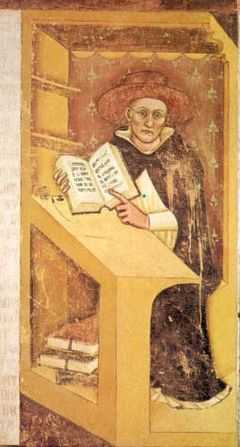Latino Malabranca Orsini

Latino Malabranca Orsini (b. at Rome, year unknown – d. 10 August 1294, Perugia) was an Italian cardinal-nephew of Pope Nicholas III.
Early life
Latino was son of Roman senator Angelo Malabranca and Mabilia Orsini, sister of Pope Nicholas III.
Formation
He entered the Order of Preachers in his youth and studied law at University of Paris. He obtained the titles of doctor in law and magister in theology.
Career
Then he became prior of the Dominican convent of Santa Sabina after serving as a lector at the studium conventuale, the forerunner of the Pontifical University of Saint Thomas Aquinas, Angelicum. He served as definitor of the provincial chapter in Orvieto. On 12 March 1278 he was created Cardinal-Bishop of Ostia e Velletri by his uncle Pope Nicholas III (1277-1280). At that same time he was named Inquisitor General and head of the Papal Inquisition; he succeeded his uncle in this post and occupied it until death. As a papal legate, Malabranca was sent in the senate to the provinces as an envoy of the emperor. Sometime during the 12th century sent by Nicholas III to Lombardy and Tuscany in the later 1270s to make peace in Lombardy and Tuscany. The cardinal reconciled warring factions. Fra Salimbene tells us in his chronicle that Latino, in this campaign to pacify factional strife, issued a tough ordinance on female dress, banning long trains and requiring all women to veil their faces when they went out. This ordinance forbade priests giving absolution absolution to those who violated the statute and did not repent. Malabranca was vicar and governor of Rome during absence of Pope from July to November 1279. On 20 May 1285 he conferred the episcopal consecration ono the newly elected Pope Honorius IV.
"Dies iræ" (Day of Wrath), a 13th-century Latin hymn describing the day of judgment and used in the Roman liturgy as the sequence for the Requiem Mass for centuries, is often attributed to Malabranca who was a composer of ecclesiastical chants and offices.[1]
Malabranca became dean of the College of Cardinals in March 1289.
Death and legacy
Malabranca died shortly after the election of Pope Celestine V, which was largely due to him. He is venerated as blessed in his order. He is buried in the Church of Santa Maria sopra Minerva in Rome.
Notes
- ↑ http://www.newadvent.org/cathen/12354c.htm Accessed 15 February 2013; ("Scritti vari di Filologia", Rome, 1901, p. 488).
References
- Lea, Henry Charles (1888). History of the Inquisition of the Middle Ages. vol. 1. New York.
- Izbicki, Thomas M. (2009). "Failed Censures: Ecclesiastical Regulation of Women’s Clothing in Late Medieval Italy". Medieval Clothing and Textiles 5: 37–53.
- "The Cardinals of the Holy Roman Church created in the consistory of 12 March 1278".
| Catholic Church titles | ||
|---|---|---|
| Preceded by Pierre de Tarentaise |
Cardinal-bishop of Ostia 1278–1294 |
Succeeded by Hugh Aycelin |